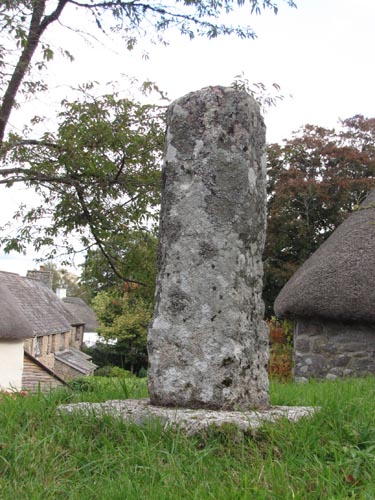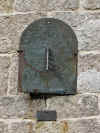|
Location:
Inside the lychgate to the churchyard, take the path which goes around to
the left and the cross shaft is set up on the bank on your left.
O/S Grid Ref: SX/66793/90775
Longitude/Latitude (Degrees+/-): -3.88765/50.70131
Map location: Click here
to view map.
Purpose: Not
known.
Size: 3
feet 5 inches (1.05 metres) tall. 12½ inches (0.32 metres) wide.
Information:
All that remains of this cross is the
shaft, set into a square base. Nothing is known of the whereabouts of its
head and arms. The bottom 11 inches of the shaft is square and it is
chamfered above. The base stone is 2 feet 6 inches (0.77 metres) wide by 2
feet 7 inches (0.80 metres) deep. The top of the base is about 6
inches (0.15 metres) above the ground. There is a shallow hole drilled
into the face of the shaft, towards the path, which looks as though it
might have been started for a gate hanger, but not completed.
The shaft was found,
built into one of the walls of the farm buildings, during renovation work
at Throwleigh Barton in 1977. It was by kind permission of the owners, Mr
and Mrs Hodgson, that the shaft has been erected at its current site. A
small brass plaque, screwed to the edge of the base stone, gives a brief
outline of its history:
|

|
Ancient cross
shaft
found during
restoration work at
Throwleigh Barton
1977 |
|
On a small
patio around the left hand side of the church, just past the main
entrance, there is what appears to be another short section of a
cross shaft. This is just the base of the shaft, which is square
for the lower 9 inches and chamfered above. It measures 1 foot 4
inches (0.40 metres) tall, 1 foot 4½ inches (0.41 metres) wide
and 1 foot 6 inches (0.45 metres) deep. |
|
 |
|
 I have not been able
to find out where it came from or what has happened to the rest of the
cross. I have not been able
to find out where it came from or what has happened to the rest of the
cross.
Behind this stone and
leaning up against the church wall are three very old tombstones. The
right hand one is fairly plain. The left hand one is made from granite, is
very old and is almost in the shape of a cross. However, the central one
is of most interest. It is made of slate and has an oval Egyptian type
head engraved at the top, with large wings coming out each side from under
the chin. The inscription, below the head, reads as follows:
|
|
 (The letters shown in
brackets are missing off the edge of the stone and have been assumed.
Where the letters TH appear together, the vertical line of the T is shared
with the left hand vertical line of the H. Each single word has a dot
between it and the next word). (The letters shown in
brackets are missing off the edge of the stone and have been assumed.
Where the letters TH appear together, the vertical line of the T is shared
with the left hand vertical line of the H. Each single word has a dot
between it and the next word).
 There is a fine stone
porch covering the main entrance to the church. Inside the porch and
resting on one of the wooden benches is a stone with two parallel lines
engraved across it, forming a right angle. This stone is sure to have some
significance, but I’m afraid that I have been unable discover what it
is. Over the porch, a slate sundial is attached to the wall at a slight
angle. This is probably to ensure that it shows the correct time and it
was certainly accurate on the day of my visit. The plaque shows that it is: There is a fine stone
porch covering the main entrance to the church. Inside the porch and
resting on one of the wooden benches is a stone with two parallel lines
engraved across it, forming a right angle. This stone is sure to have some
significance, but I’m afraid that I have been unable discover what it
is. Over the porch, a slate sundial is attached to the wall at a slight
angle. This is probably to ensure that it shows the correct time and it
was certainly accurate on the day of my visit. The plaque shows that it is:
|